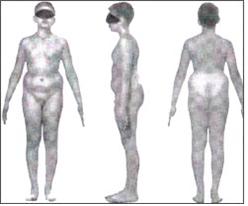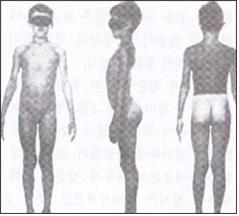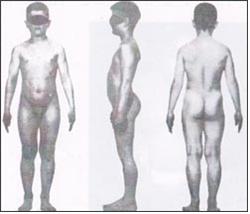체형, Somatotype

그림 1-86. 내배엽 형.
Used with permission from Nelson Textbook of Pediatrics,15th Ed와 소아가정의학백과
- 어떤 일정한 신체적 특징에 의해서 결정되는 체격의 특정한 범주를 체형이라고 한다.
- 사람들의 체형을
-
- 내배엽형(Endomorphy),
- 중배엽형(Mesomorph),
- 외배엽형(Ectomorphy)으로 3분 할 수 있다.
- 쉬운 말로 표현한다면,
-
- 내배엽형은 뚱뚱한 체형,
- 중배엽형은 근육질 체형,
- 외배엽형은 마른 체형이다.
| 내배엽형(뚱뚱한 체형) |
- 내배엽형(뚱뚱한 체형)을 가진 부모들로부터 태어난 아이들은 부모들의 체형(體型)과 체질을 닮아서 뚱뚱한 체형을 갖고 태어나고
- 어려서도 뚱뚱한 체형을 가지고 자라고 성인기 동안에도 뚱뚱한 체형으로 사는 것이 보통이다.
- 내배엽형(뚱뚱한 체형)을 가진 아이들의 대부분은 다음과 같은 특징이 있다.
-
- 음식물 종류 이것저것 가리지 않고 즐겨 먹는 편이고
- 식물성 음식물보다 쇠고기나 돼지고기 등 육류 음식물을 더 즐겨 먹는 편이다.
- 쉽게 잠들고 많이 잠자는 편이다.
- 그들은 신생아기부터 사춘기가 될 때까지 또 성인기에 이르러서도 뚱뚱한 체형을 계속 유지하는 것이 보통이다.

그림 1-87. 외배엽형.
Used with permission from Nelson Textbook of Pediatrics,15th ed 및 소아가정의학백과

사진 1-88. 중배엽형.
Used with permission from Nelson Textbook of Pediatrics,15th ed 및 소아가정의학백과
| 외배엽형(마른 체형) |
- 내배엽형와 달리, 외배엽형(마른채형)을 가진 부모들로부터 태어난 아이들은 부모의 체형을 닮아 마른 체형으로 성장 발육하는 것이 보통이다.
- 마른 체형을 가진 아이들의 대부분은 음식물을 가려 먹는 편이고 소량 먹으며 육류 음식물보다 식물성 음식물을 더 즐겨 먹는 편이다.
- 일반적으로 쉽게 잠들지 않고 잠을 오랫동안 깊이 자지 못한다.
- 마른 체형을 가진 아이들은 나서부터 사춘기까지, 또 성인이 되어서도 마른 체형으로 일생동안 사는 것이 보통이다.
| 중배엽형(근육질 체형) |
- 근육질 체형을 가진 아이들은 먹고 자는 습성 등이 뚱뚱한 체형에도 속하지도 않고 마른 체형에도 속하지 않지만 그 두 가지 체형의 특징의 중간에 속하는 특징이 있는 체형이다.
- 이론적으로 사람들의 체형을 이렇게 세 가지 체형으로 분류할 수 있지만 꼭 그런 뚜렷한 세 가지 체형으로 분류하기가 어렵다.
- 태어 날 때부터 기르기가 쉬운 아이들도 있고 기르기가 어려운 아이들도 있다.
- 또 25 퍼센타일(Percentile) 성격도 있고 75 퍼센타일 성격도 있다.
- 각 아이들은 태어날 때부터 제 각기 다른 9가지 기질을 갖는다.
- 즉 각 아이들은 타고 날 때부터 서로 다른 기질을 가진다.
- 부모들이 25퍼센타일 성격, 75퍼센타일 성격, 타고 난 9가지 기질 등에 관한 정보를 알고 또 부모들은 자녀들의 체형이 어떤 체형에 속하는지 알면 자녀들을 양육하는 데 많은 도움이 될 것이다.
Body type Somatotype

Figure 1-86. Endoderm type.
Used with permission from Nelson Textbook of Pediatrics, 15th Ed and Encyclopedia of Pediatric and Family Medicine
• A specific category of physique that is determined by certain physical characteristics is called body type.
People’s body shapes
o Endomorphy,
o Mesomorph,
o It can be divided into 3 ectomorphy.
• To put it in simple words,
o Endoderm is obese,
o Mesodermal type has a muscular body,
o Ectomorph is skinny.
Endoderm (fat body type)
• Children born to parents with an endoderm type (obese body type) are born with an obese body type because they resemble their parents’ body type and constitution.
• It is common to grow up with a fat body shape even as a child and live with a fat body shape during adulthood.
• Most children with endoderm (fat body type) have the following characteristics.
o They enjoy eating regardless of the type of food.
o They prefer to eat meat foods such as beef and pork rather than plant foods.
o They tend to fall asleep easily and sleep a lot.
o They usually remain obese from infancy through puberty and into adulthood.

Figure 1-87. Ectodermal. Used with permission from Nelson Textbook of Pediatrics, 15th ed, and Encyclopedia of Pediatric and Family Medicine

Picture 1-88. Mesoderm. Used with permission from Nelson Textbook of Pediatrics, 15th ed and Encyclopedia of Pediatric and Family Medicine
Ectomorph (Skinny body)
• Unlike endoderm, children born to parents with ectoderm (skinny) usually grow and develop with a skinny body shape that resembles their parents’ body type.
• Most skinny children tend to eat small amounts, and they prefer to eat plant foods rather than meat foods.
• They generally do not fall asleep easily and sleep deeply for long periods of time.
• It is common for skinny children to be skinny throughout their lives from childhood to puberty and into adulthood.
Mesodermal type (muscular body type)
• Children with muscular body types have characteristics such as eating and sleeping habits that do not belong to either a fat body type or a skinny body type, but fall between the two body types.
• Although it is theoretically possible to classify people’s body types into these three body types, it is difficult to classify them into three distinct body types.
• From birth, some children are easy to raise and some are difficult to raise.
• There are also 25 percentile personalities and 75 percentile personalities.
• Each child is born with nine different temperaments.
• That is, each child is born with a different temperament.
• If parents know information about the 25th percentile personality, the 75th percentile personality, the 9 natural temperaments, etc.
출처 및 참조문헌
- Nelson Textbook of Pediatrics 22ND Ed
- The Harriet Lane Handbook 22ND Ed
- Growth and development of the children
- Red Book 32nd Ed 2021-2024
- www.drleepediatrics.com 제1권 소아청소년 응급 의료
- www.drleepediatrics.com 제2권 소아청소년 예방
- www.drleepediatrics.com 제3권 소아청소년 성장 발육 육아
- www.drleepediatrics.com 제4권 모유,모유수유, 이유
- www.drleepediatrics.com 제5권 인공영양, 우유, 이유식, 비타민, 미네랄, 단백질, 탄수화물, 지방
- www.drleepediatrics.com 제6권 신생아 성장 발육 육아 질병
- www.drleepediatrics.com제7권 소아청소년 감염병
- www.drleepediatrics.com제8권 소아청소년 호흡기 질환
- www.drleepediatrics.com제9권 소아청소년 소화기 질환
- www.drleepediatrics.com제10권. 소아청소년 신장 비뇨 생식기 질환
- www.drleepediatrics.com제11권. 소아청소년 심장 혈관계 질환
- www.drleepediatrics.com제12권. 소아청소년 신경 정신 질환, 행동 수면 문제
- www.drleepediatrics.com제13권. 소아청소년 혈액, 림프, 종양 질환
- www.drleepediatrics.com제14권. 소아청소년 내분비, 유전, 염색체, 대사, 희귀병
- www.drleepediatrics.com제15권. 소아청소년 알레르기, 자가 면역질환
- www.drleepediatrics.com제16권. 소아청소년 정형외과 질환
- www.drleepediatrics.com제17권. 소아청소년 피부 질환
- www.drleepediatrics.com제18권. 소아청소년 이비인후(귀 코 인두 후두) 질환
- www.drleepediatrics.com제19권. 소아청소년 안과 (눈)질환
- www.drleepediatrics.com 제20권 소아청소년 이 (치아)질환
- www.drleepediatrics.com 제21권 소아청소년 가정 학교 간호
- www.drleepediatrics.com 제22권 아들 딸 이렇게 사랑해 키우세요
- www.drleepediatrics.com 제23권 사춘기 아이들의 성장 발육 질병
- www.drleepediatrics.com 제24권 소아청소년 성교육
- www.drleepediatrics.com 제25권 임신, 분만, 출산, 신생아 돌보기
- Red book 29th-31st edition 2021
- Nelson Text Book of Pediatrics 19th- 21st Edition
- The Johns Hopkins Hospital, The Harriet Lane Handbook, 22nd edition
- 응급환자관리 정담미디어
-
소아가정간호백과–부모도 반의사가 되어야 한다, 이상원
-
Neonatal Resuscitation American heart Association
-
Neonatology Jeffrey J.Pomerance, C. Joan Richardson
-
Pediatric Resuscitation Pediatric Clinics of North America, Stephen M. Schexnayder, M.D.
-
Pediatric Critical Care, Pediatric Clinics of North America, James P. Orlowski, M.D.
-
Preparation for Birth. Beverly Savage and Dianna Smith
-
Infectious disease of children, Saul Krugman, Samuel L Katz, Ann A. Gershon, Catherine Wilfert
- 소아과학 대한교과서
- Growth and Development of Children, Eighth Edition, George H. Lowrey, Yearbook Medical Publishers
- Growth and Development of Children, Fifth Edition, E. H. Watson and G. H. Lowrey, Yearbook Medical Publishers
- Other
|
Copyright ⓒ 2015 John Sangwon Lee, MD., FAAP 미국 소아과 전문의, 한국 소아청소년과 전문의 이상원 저 “부모도 반의사가 되어야 한다”-내용은 여러분들의 의사로부터 얻은 정보와 진료를 대신할 수 없습니다. “The information contained in this publication should not be used as a substitute for the medical care and advice of your doctor. There may be variations in treatment that your doctor may recommend based on individual facts and circumstances. “Parental education is the best medicine.” |